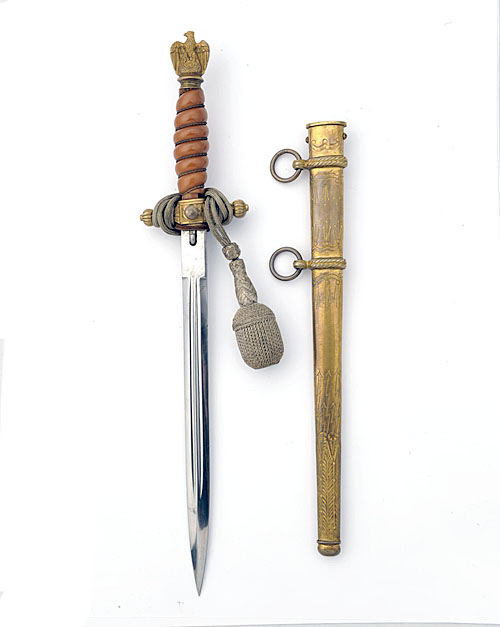Product Details
A GERMAN KRIEGSMARINE 'TYPE TWO' NAVAL DIRK, UNSIGNED,
circa 1939, with double-fullered unsigned 9 3/4in. stiletto blade, gilded cross-guard with button locking catch, spiral wire-bound orange plastic hilt with gilded eagle and swastika pommel, the whole retaining much original finish TOGETHER WITH its original gilded brass scabbard with lightning-bolt designs and bullion portapee knot (lightly tarnished)
Provenance: The German Navy holds a long and honourable tradition. Unlike the other services, German Navy uniforms and accoutrements have been historically slow in reflecting change. For example, the German Navy edged weapons, which remain in service today, bear only minor modifications to the edged weapons carried by members of the Royal Prussian Navy in the mid-nineteenth century. The Prussian and German Navies prior to the 3rd Reich, had a history of wearing dress daggers going back to 1848. Initially "Dirks" were worn only by cadets until 1901 when their use was extended to all officers. The basic appearance changed very little over the period from 1848 until 1919 when the Imperial "Crown" pommel was superseded by the "cresting wave and reed ball" style pommel. A black scabbard was also introduced. In 1921 the scabbard was converted back to the gilded unit with two suspension rings as pre 1919. In 1929 the grip was also converted back to the pre 1919 traditional white grip. The dagger continued in the above format until 1938 when, upon Hitler's birthday, the Navy Type Two was issued for wear. The main change was the replacement of the cresting wave and reed ball pommel for the Nazi eagle holding a swastika. The 9 3/4in. long blade was often etched with various naval patterns ranging from ships, anchors or similar naval motifs. Some blades such as the one featured here were plain with no etching. The dagger was locked in the scabbard by a small brass stud set in the cross-guard. The grip was normally of white celluloid over a wood base with twisted double stranded brass wires running down the grooves of the grip. Some makers used a solid plastic grip that can range from a pale butter yellow to a deep dark orange such as here. Ivory grips were also available as extra cost items. A 16 1/2in. silver bullion or aluminium portapee knot was authorized for wear, again represented here. Note that later made portepees are constructed from a rayon-type material. The base of the ball area has a gray twisted woven string like stuffing. Wearing of the Navy dagger was discontinued in December 1944.
Estimate £300-400

